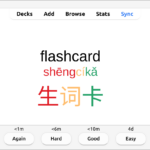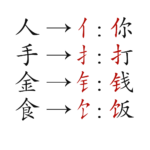Articles in the ‘Vocabulary’ category Page 2
-
Why flashcards are great for learning Chinese
The humble flashcard: A key component in a successful strategy, or a distraction from what truly matters? Few things have sparked as much debate as the use of flashcards for learning a foreign language.
Read → -
Is learning things by heart good for improving your Chinese?
Learning things by heart used to be a mainstay of language education but is now often frowned upon. Is learning things by heart good for improving your Chinese or just a waste of time
Read → -
Student Q&A, November 2023: Reading Pinyin or characters, comprehensible vs. compelling content and reading tools
How do you transition from reading Pinyin to reading characters? Are compelling texts better than comprehensible texts? And which tools should you use when reading Chinese?
Read → -
Shapeshifting Chinese characters
Most Chinese character components are well-behaved; they look the same in different compounds and aren’t hard to recognise. Some components are sneaky, though; they change appearance depending on context! Let’s have a closer look at these shapeshifting characters.
Read → -
Student Q&A, October 2023: Expanding vocabulary quickly, learning by watching videos and nailing dictation tests
How do you build a broad vocabulary in Chinese quickly? How do you best use video-sharing platforms to boost your learning? And how should you study to nail all your 听写 or dictation?
Read → -
Student Q&A, September 2023: Listening more than once, assessing pronunciation and the merits of flashcards
Is it good to listen to the same passage more than once? How do you assess progress with pronunciation? And are flashcards really all that good for learning Chinese?
Read → -
Should you throw away your Chinese textbook?
Many students rely on textbooks to learn Chinese, but is this a good idea? Some people say that to unleash your full potential, you should throw your textbook away.
Read → -
How narrow reading and listening can help you bridge the gap to real Chinese
Varying your diet of Chinese reading and listening practice is often considered good, indeed necessary, for your learning, but this could be wrong. In some cases, variation makes things too difficult, and then narrow reading and listening is a better option!
Read → -
Skritter review: Boosting your Chinese character learning
Skritter is a modern tool for learning ancient characters. It combines research-based methods such as active recall and spaced repetition with great Chinese-specific tools and content. While it’s not a free resource, it has enough edges over more generic, free services to be worth it in my opinion.
Read → -
Vocabulary lists that help you learn Chinese and how to use them
Learning new characters and words from a list is rarely a good idea, but there are exceptions! Let’s have a look at five types of vocabulary lists how to use them to learn Chinese.
Read →









